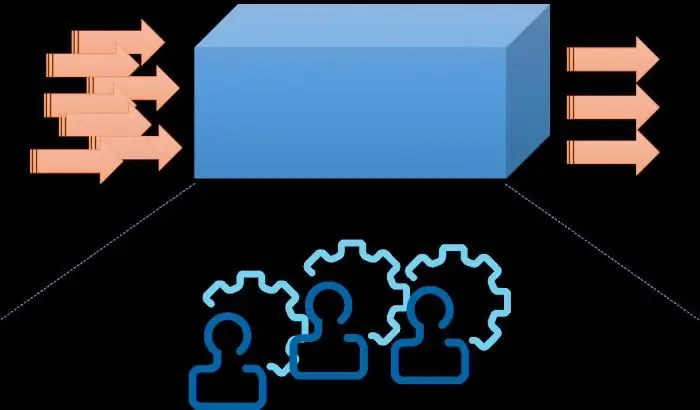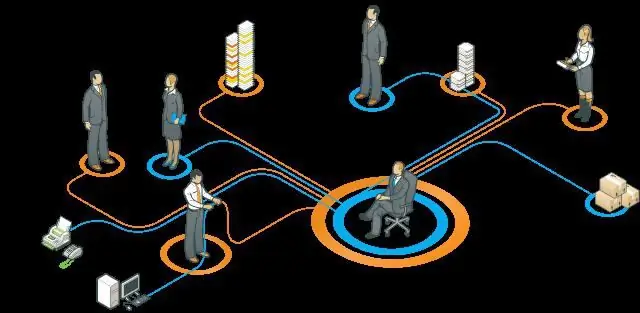2026 Author: Howard Calhoun | [email protected]. Last modified: 2025-01-24 13:10:29
The management procedure of any organization is a complex cyclical process that requires a clear understanding. It is important to know not only the stages of production, but also to understand what the internal and external environments of an enterprise are, as well as to determine their degree of influence on business entities.
The essence of the economic activity of the enterprise
Each organization carries out a complex process, which involves all links and divisions of the subject of modern business. The economic activity of the enterprise is the interaction between all components of production throughout the full cycle from the purchase of raw materials to the sale of goods to the consumer.

To successfully manage a business, it is not enough to understand the mechanisms of interaction between the constituent elements, but it is also necessary to analyze the process both from the inside and outside.
For the purpose of a detailed and correct analysis, the economic activity of the enterprise is divided into severalaspects, from which the main indicators are distinguished, which are used to track the dynamics of activities in different reporting periods.
Synthesizing analysis methods are often used: all indicators are combined into a single mechanism, and the relationship between them is monitored, the degree of influence on each other and the level of interdependence of factors among themselves are determined (for example, how indirect costs depend on gross income and in the reporting period or in the previous one).
Activities
Undoubtedly, the type of activity of the organization plays an important role in the direct analysis procedure. You cannot evaluate by the same ratios, for example, a private hotel complex and a company that produces plastic bags with a state share in the capital.

Depending on the form of ownership, there are private and public enterprises. The latter types are distinguished by the fact that they have a part of the state capital. The former include private and cooperative economic entities.
In addition, the type of activity of the organization according to the degree of entrepreneurship can be both commercial and non-commercial. In this case, the name speaks for itself - the latter do not make it their primary task to make a profit as a result of their main activity and rather function according to trade union, religious and fund principles.
Also, in Russian legislation, there is a ranking of organizations according to economic typesactivities. This list is included in the Unified Classifier and is represented by groups that include about a hundred items.
Enterprise Environment: Definition
An organization cannot function in isolation, according to its plans and tasks, without interfering with the factors influencing its activities. The reasons can be varied: weather conditions, the actions of competitors, the work of the accounting department, certain actions of the staff of the recruitment department, etc.

All these events can be summed up under a separate concept - the environment of the enterprise. Not a single business entity can do without it, and sometimes the environment can influence both positively and negatively, despite the abstractness of its definition as such.
Let's say a person was late for work because his car broke down - he was negatively affected by the external environment. But if he had arrived early for the reason that he met an old friend and he gave him a ride, then there is a positive influence of the external environment.
A business entity is no exception - its activities can be affected by the internal and external environment of the enterprise in a positive or negative aspect.
What is the enterprise environment like
So, we have decided that any changes in the functioning of a business entity depend on factors affecting the production process.

However, it is not entirely correct to separate the influencingindicators on purely internal and external environments of the enterprise, since each of them can be divided into several subgroups. So, for example, any field of activity can be divided according to the degree of influence, the factors of the distribution of forces and the area of influence.
Enterprise internal environment
Any components that take place within the enterprise and somehow affect the economic process are elements of the internal environment of the economic entity. This phenomenon is a completely manageable process and can be regulated in any way by any management decisions, which in its totality constitutes a mechanism for interaction between technological and organizational engines.
Internal and external environments of the enterprise have a clear distinction between themselves in terms of their components, so the elements of the first are:
- human resources (ordinary personnel);
- managerial capabilities (leadership);
- technological stocks (production equipment);
- advertising promotion of goods (marketing group);
- financial security;
- company culture;
- social image.
These indicators are not constant, so some business entities may not have some of them. All of the above elements can be combined and highlight the factors of the internal environment of the enterprise:
- economy (includes marketing and financial elements);
- work capacity (cultural and image elements of the environment, staff structure);
- technology support (includes the entire production team).
The procedure for analyzing all of the above forces allows the enterprise to strengthen all its weaknesses and improve its strengths, which allows the business entity to gain greater resilience in the foreign market.
Enterprise internal environment by example
Let's take a practical look at how changes in the internal environment can affect the business as a whole.
Let's say you have a staff that is a little bit skilled, but not enough to work quickly and efficiently. You, as a manager, organize refresher courses aimed at the specifics of your company.

As a result, after completing the courses, the personnel receive answers to many of their questions and now it takes less time to perform direct duties, since the employee does not spend his working time turning to colleagues for help, and thereby distracting them from their work.
We have considered changes in the labor factor, let's try to change something in the technological support. For example, replacing equipment with a newer one. Thus, we exclude or minimize stagnation in production due to a breakdown of one or another mechanism. And this means that we no longer spend money on the repair of fixed assets, thereby affecting the economic factor, changing indirect costs for capital investments.
Working environment
Since we are talking about technologicalsecurity, let's dwell on the production environment of the enterprise in more detail, as one of the main components of the internal.
Product planning should be treated with the greatest responsibility by every manager, since this component, although not constant, is one of the longest.
The production environment of an enterprise includes the following components:
- any space in which the work process is carried out: including main structures, outbuildings with all infrastructure included;
- software and hardware that is involved in the main process;
- other services and systems that are involved in the auxiliary production line.
Each section of the production area must be equipped in such a way that it can serve the enterprise for many years.
Enterprise environment
Any environment outside the business entity that in any way affects its activities, even indirectly, is called the external environment of the enterprise. At the same time, it has macro- and micro-influences. The former relate to indirect driving forces, while the latter are based on the activities of other entities directly related to the enterprise.

Main factors of the external environment of the enterprise:
- nature (weather conditions, impact on production by changing them);
- demographic indicator (change in average agepopulation);
- economic component (any processes taking place in the country and affecting national and foreign exchange markets, the presence of competitors);
- institutional engine (any action by government and fiscal authorities).
Thus, we can say that the external environment of the enterprise is in no way subject to management decisions and can affect the business entity chaotically, without a clear algorithm and direction vector.
External environment by example
Let's use an example to imagine how the external environment of an enterprise affects a business entity in a demographic aspect. Let's say there is a corporation that has been manufacturing baby products for several decades, while in recent years the average birth rate has decreased by 20%.

Roughly speaking, entrepreneurs will have to adapt to demographics and slightly reduce volumes (unless, of course, they have not managed to enter the foreign market in these same reporting years).
Let's consider how the natural factor can affect a business entity. For example, a hurricane, a storm warning - and the supply of raw materials is disrupted due to adverse weather conditions.
Institutional indicator manifests itself in practice under the guise of government regulations, changes in legislation and the taxation process. Jumps in exchange rates constitute an economic factor, in which the competitive environment of the enterprise also plays an important role, with which, by the way, the manufacturer canlittle fight.
Competitive environment
It is known that competition is a kind of rivalry process, which may be due to the release of the same goods sold in the same geographical areas.
You can fight the competitive environment by varying some indicators of your business. For example, pricing policy. The cost of goods is one of the indicators that directly affect the choice of the buyer. Therefore, the lower it is, the higher the demand.
However, do not forget about the quality of products. Often unscrupulous manufacturers sacrifice quality for the sake of lowering the price threshold. There are other ways to reduce the cost of a product, such as reducing supply costs or automating the production process, thereby reducing direct production costs.
Recommended:
Management. Internal and external environment of the organization: concept, characteristics and examples

The external and internal environment of an organization in management depends on a combination of economic factors. This is the ability to compete, the profitability of the company, the performance indicators of the adopted strategy and the conditions for further development
External combination. Combination and concurrency. How to apply for an external partnership

External part-time employment - a form of employment that allows you to work, in addition to the main job, for several more
Internal and external environment of the organization: defining the relationship

The activity of any business entity is influenced by the internal and external environment of the organization, with the help of which actions are determined, as well as the ways of their functioning in the long term. All this directly depends on the ability of the subject to adapt to certain expectations and specific requirements of the environment
The business environment is The concept, types and formation of the business environment

Running your own business is quite complicated and requires a lot of effort and energy. It becomes real only when the entrepreneurial environment is sufficiently developed in the region of residence of a businessman, this implies the availability of appropriate opportunities from an economic point of view
External financing and internal financing of the enterprise: types, classification and features

The key to the successful operation of an enterprise, its development and competitiveness is to correctly and effectively combine internal and external sources of financing. The ratio of own and borrowed funds depends on the field of activity of the company, its size and strategic plans

